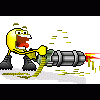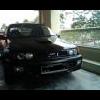Search the Community
Showing results for tags 'brakes'.
-
Why some cars have drum brakes and why some cars have disc brakes? Which one is actually better?
-
Are they still teaching "L" drivers to tap their brakes when they are uncomfortable with another car following behind them? Personally, i think this is one of the stupidest thing ever taught. Everyday i face this kind of people on the roads, even when there's absolutely no cars ahead of them. If you're not comfortable with matching the flow of traffic, then find an opportunity to keep to the left. If cannot or refuse to keep left, just maintain your speed and leave it to the driver behind to overtake you either left or right when an opportunity presents itself. There are even some idiots who intentionally slow themselves down to the same speed as the car beside so as to deny the car behind with the opportunity to overtake. Why need to do something like that? It is already so blardy irritating when somebody hogs the road. To tap their brake some more is simply dumb, and to intentionally slow down to prevent being overtaken is an invitation for retaliation.
-
I think for all road users including pedestrians, a little respect, a little patience and a little tolerance goes a long way to prevent senseless accidents... From ST Forum: http://www.straitstimes.com/STForum/Story/...ory_763407.html Put the brakes on bad driving habits
-
Hi guys, recently i'm feeling that the brakes are starting to get spongy... the funny thing is that when i just move off the car, the brakes are superb, but after say about 1km of driving or so, the spongy feeling comes back... stepping the brake pedal from 1/4 to 1/2 has very little effect but from 3/4 onwards all the braking power comes back and brings to almost immediate stop... in nutshell, i have to step harder than before to stop... my brake pads and rotor are brand new btw... changed at 40k KM (now 42K KM) i did a google and it seems it points to air pockets and i need to "bleed" the brake system? sounds like quite a waste as my brake fluid is only less than 2000km old and using liqimoly, its not cheap... or could it be a brake hose issue? changing to stainless steel will help?? but most imply, can someone share with me why does the brakes not feel spongy when i just got my engine started up and begin to move off and the spongy feel only sets in after some traveling? thanks
-
More than a dozen motorists a day are pulled up for infringements like modified exhausts, overly tinted windows and various lighting offences. In the first half of the year, Land Transport Authority (LTA) enforcement officers issued 2,512 summonses - almost double the 1,337 in the corresponding period last year . The 2,512 figure matches the full-year haul of last year (2,645) and 2009 (2,510) and surpasses the 1,746 in 2008. The LTA keeps a relatively tight rein on what changes can be made to a car because of safety issues. Source: http://www.straitstimes.com/BreakingNews/S...ory_725312.html
-
Hi guys, is there any timeline or mileage to change coolent? I last change my coolent to toyota long life premix in feb 2010, now mileage is another 35k km liao. Do i need to change after 30k or 1 year like EO? How abt brakes? Last service june 2010, now its another 25k km mileage, need to bleed the brake system? Thanks for advice
-
Guys, need your opinions. I am driving an 1.5year Honda Jazz GE8 (mileage approx 15k due to OPC). Since day 1, i feel that the brakes has been spongy vs. my old ride (Vios) and other rides that I have test drove (forte, mz3, lancer EX). I have been ignoring till recently. Can I check does a simply flushing of brake fluids do the trick? I called up stamford tyres and they recommend me: 1) flush with DOT4 fluid. ($40) 2) change to brembo rotors (front) @ $140/rotor 3) change 4x brake pads (dunno what brand) @ $190 for 4 pads and 4) [he mentioned this is optional] change to 4x stainless steel braided hose @ $320 (4 hoses) I am more include in taking up first 3 option and give up SSBH. However my concern is, will the changing of non-stock brake pads wear off my rear rotor? Will it be dangerous? If i change merely front rotor and front brake pads, i guess the car will nose dive due to the better brakes in front. Any comments guys???
-
My lancer ex has this warning lit at the console, beside chopper c&c is there anywhere reasonable priced workshop that can help me. Thank you
-
Hi bros I got a qns here..when do we normally need to replace the brakes rotors ? Currently reaching to 40K mileage, I change e pads to mintex which i think i wears the rotor out faster than the stock pads. Can feel many grooves when i run my fingernails over the rotors..so I was wondering if there is any rule of thumb like to change rotors during 80K servicing or so etc...any kind bros can give me some advice ? I
-
What is the reason ? i often saw those cars with rusty brake disk ... from what i know is not cause by rain , else my car would have those rusty brakes too ... someone enlighten me pls ? Happy chinese new year !
-
Dear all Seniors, Just to check........ 1) Can Toyota Corolla AE101 front rotors, calliper and master brake pump (the black round thing) direct bolt on to our EP80? Current stock brakes I find that cannot make it and I think Corolla brake kit is easier to find than EP82 brake kit. 2) Both 1.3 and 1.6 is it the same? 3) Will changing of better brake pads help (using back stock callipers and rotors)? What are the brands available and estimate cost? Thanks in advance.
-
Hi all, I'd just changed my 2 front wheel's brake rotor and brake pads 2 weeks ago. Encountered something weird today... Was travelling along ECP when I suddenly needs to jam brake (Not e-brake kind of jam brake, but the step hard on brake kind of jame brake). I can hear a sharp screeching sound, but car managed to slowed down as per expected. When I reached the carpark shortly after that, I realised that 1 of my front wheel has smoke coming out of it. could it be due to the semi-hard braking I just did ? Or could it be something more ?
-
Hi bros, I was thinking of improving my brakes but is clueless about it. May I get some advices on better brakes? To change brake pads or the whole brakes? What brand is good and roughly the damages? Thks!
-
Anyone knows how to adjust rear brakes? my brakes feels spongy after changing pads and bleeding was done. And i checked that the rear brakes need to be adjusted. Saw my mech adjust something near the wheel hubs. Anyone know where to adjust them?
-
Ok bros, I've done some research into GT brakes and hope to share info with you guys. I found it to be a real nightmare looking for parts. Call me fussy, but I do not believe in being cheap on braking components, so I wanted brand new rotors. Just to let you know that the front rotors for EP82 have only a 1mm run-out before reaching it's minimum of 17mm. I found that my rotors were skimmed (or turned) before and it's now down to 16mm. Intro For those who don't know the GT Brake Kit refers to the brake system off a EP82 GT. It's a four-disc system, with front ventilated and rear solids. It's an easy swap onto EP80s with a more wimpy brake system. Rotors Specs Front Rotors Diameter: 254mm Thickness: 18mm Minimum Thickness: 17mm Centre hub bore: 54mm PCD: 4x100 Front Toyota OEM: 43512-10110 (EP82) / 43512-16080 (Paseo EL44) Brembo 09.6765.10 (on indent basis only) Rear Toyota OEM: 42403-19105 These can be found at a stockist called YUNG SOON AUTO SUPPLY CO (Tel: 62986988). They can special order from Toyota Japan if they don't have it in stock. Pads Now comes the fun bit. It seems that we have a VERY limited choice for performance pads now. Ferodo (FCP308H) is sold out, Mintex (MDB1251) and Bendix (DB308) are also out. Even Thai-made N-brakes are sold out! So what are we left with? Toyota Originals Front 04465-10040 Rear 004466-18010 (no other choices - even the Oz guys have to use these) Other brands for front pads Project Mu (Stamford Tyres) Front: F182 (Bestop up to 350deg or B-Spec up to 500deg) EBC Greenstuff can be special ordered, part number: DP2453
-
TAICHUNG, Taiwan - A Toyota collided with a pillar in front of a convenience store in central Taiwan Saturday as the driver was parking the car, local reports said yesterday. According to the driver, a 36-year-old woman, she was putting the car into park when her four-year-old Toyota Wish lurched forward and hit the store in Taichung County. "The car had stopped. But when I was shifting gears, it lurched forward on its own and the brakes did not work," she said. No casualties were reported, but the driver's mother, who was sitting in the front passenger seat when the incident occurred was taken to a hospital complaining of chest pains, the reports said. A Toyota technician who rushed to the scene to check the problem said there would be an investigation into the case, which came after Toyota recalled some 8.5 million vehicles worldwide since October last year due to problems with the accelerator pedal and braking system. Toyotas sold in Taiwan use a different brand of accelerator pedal than the one that has been causing problems elsewhere.
-
In the latest blow to a Japanese automaker, Honda will recall 412,000 vehicles to fix a faulty braking system. Consisting of 344,000 Odysseys and 68,000 Elements, from 2007 and 2008, the recall aims to fix "soft" brake pedals. When the 'vehicle stability assist modulator' tests itself on startup, a small amount of air is allowed into the hydraulic brake lines. Over time, the air can build up and cause the brake pedal to require more force to get the vehicle to stop. According to Honda spokesman Chris Martin, "It's definitely not operating the way it should, and it's safety systems, so it brings it to the recall status." Owners will receive a letter in the mail, by the end of April, with additional information about the recall. If your vehicle already has a "soft" pedal, Honda dealers can bleed the braking system which should temporary fix the problem until recall parts (plastic caps and sealant) are available. So far, the National Highway Traffic Safety Administration (NHTSA) has reported three crashes related to the recall. No one has been killed, but minor injuries have been reported. Source: detnews.com
-
i was wondering which is a better set of brakes? also, if the gt brakes are better in terms of performance, will it be a direct plug and play?
-
Hi bros.. yday i was jammed in the expressway during peak hours.. and road condition was wet cos just stopped raining.. when the car in front of me moved further the gap opened in front of me.. so i picked up speed from 20kmh to abt 50kmh.. of cos keeping a safety distance. the car in front suddenly jammed brake.. i quickly braked hard too.. at dis moment i felt brake was working.. but i felt and heard sounds like 'klog klog klog' continuously at the front wheel.. the brake seemed working but the car did not stop and further travelled few metres more with the sound.. i felt like losing traction.. i dunno what's wrong.. been driving for so many years i think it is very ignorant of me to not know what actually was wrong. could anyone advise what actually went wrong? isit brake pads worn out? brakes not working? road wet? and where did the klog sound come from? i suddenly dun dare travel in lane 1.. cos i dunno when this might happen and dunno the next time this happens how long a distance my car will keep moving before coming to a complete stop..
-
any bros using this brand nashim as seen in hotstuffs mag? how is it
-
I was told by the shop opposite of p-- ---g that he can skim and slot lines (groove lines) on my odyssey front rotor disks brakes. He's charging for this work for $150 for both disks. Brand new slotted disk is $200+ per piece. My disks brakes have travelled about 39K km. But my questions for this process are : 1. Are my disk brakes able to perform after skimming and slotted of lines? 2. Can the OEM disk brakes able to stand the braking after skimming and slotted of lines? 3. Is this process worth or are there better solutions coz not willing to spend on 4 or 6 pot? Please advise. Thanks.
-
RPM drop to very low after braking too hard = ???
-
Bear with me but this will be the longest post you will read. The reason why brakes are of interest to me after oil is that I consider stopping more important than speed. If you can't stop, all the speed in the world is going to send you straight to heaven (or hell). Taken from here http://www.gti-vr6.net/library/wheels_tire...ted_rotors.html Rotors ... Slotted or drilled ???? slotted rotors maintain approx. 96% of the friction surface drilled rotors maintain approx. 85-93% of the friction surface drilled and slotted only maintain 80-91% of the friction surface For many years most racing rotors were drilled. There were two reasons - the holes gave the "fireband" boundary layer of gasses and particulate matter someplace to go and the edges of the holes gave the pad a better "bite". Unfortunately the drilled holes also reduced the thermal capacity of the discs and served as very effective "stress raisers" significantly decreasing disc life. Improvements in friction materials have pretty much made the drilled rotor a thing of the past in racing. Most racing rotors currently feature a series of tangential slots or channels that serve the same purpose without the attendant disadvantages. the process of drilling rotors and slotting rotors was done for 1 reason and 1 reason only it is to disipate the gases that build up between the pad and the rotor which occurs under extreme heat ( when braking very aggressively like on a road course) and it has absolutely nothing to do with heat disipation. the only way to transfer more heat away is by using a larger heat sink which means use of a larger rotor whether in diameter or thickness. Since the caliper will only allow for a certain rotor thickness that solution is not very applicable because, if you are changing tha caliper opening width you might as well get a larger rotor diameter at that time 1) The brakes don't stop the vehicle - the tires do. The brakes slow the rotation of the wheels and tires. This means that braking distance measured on a single stop from a highway legal speed or higher is almost totally dependent upon the stopping ability of the tires in use - which, in the case of aftermarket advertising, may or may not be the ones originally fitted to the car by the OE manufacturer. 2) The brakes function by converting the kinetic energy of the car into thermal energy during deceleration - producing heat, lots of heat - which must then be transferred into the surroundings and into the air stream. The amount of heat produced in context with a brake system needs to be considered with reference to time meaning rate of work done or power. Looking at only one side of a front brake assembly, the rate of work done by stopping a 3500-pound car traveling at 100 Mph in eight seconds is 30,600 calories/sec or 437,100 BTU/hr or is equivalent to 128 kW or 172 Hp. The disc dissipates approximately 80% of this energy. The ratio of heat transfer among the three mechanisms is dependent on the operating temperature of the system. The primary difference being the increasing contribution of radiation as the temperature of the disc rises. The contribution of the conductive mechanism is also dependent on the mass of the disc and the attachment designs, with disc used for racecars being typically lower in mass and fixed by mechanism that are restrictive to conduction. At 1000oF the ratios on a racing 2-piece annular disc design are 10% conductive, 45% convective, 45% radiation. Similarly on a high performance street one-piece design, the ratios are 25% conductive, 25% convective, 50% radiation. 3) Repeated hard stops require both effective heat transfer and adequate thermal storage capacity within the disc. The more disc surface area per unit mass and the greater and more efficient the mass flow of air over and through the disc, the faster the heat will be dissipated and the more efficient the entire system will be. At the same time, the brake discs must have enough thermal storage capacity to prevent distortion and/or cracking from thermal stress until the heat can be dissipated. This is not particularly important in a single stop but it is crucial in the case of repeated stops from high speed - whether racing, touring or towing. 4) Control and balance are at least as important as ultimate stopping power. The objective of the braking system is to utilize the tractive capacity of all of the tires to the maximum practical extent without locking a tire. In order to achieve this, the braking force between the front and rear tires must be nearly optimally proportioned even with ABS equipped vehicles. At the same time, the required pedal pressure, pedal travel and pedal firmness must allow efficient modulation by the driver. 5) Braking performance is about more than just brakes. In order for even the best braking systems to function effectively, tires, suspension and driving techniques must be optimized ------------------------------------------- BRAKE FADE ------------------------------------------- Brake fade ... what is happening to my stopping power ??? there are a couple of causes of brake fade #1.) When the fluid boils in the calipers, gas bubbles are formed. Since gasses are compressible, the brake pedal becomes soft and "mushy" and pedal travel increases. You can probably still stop the car by pumping the pedal but efficient modulation is gone. #2.) Pad fade is when the temperature at the interface between the pad and the disc exceeds the thermal capacity of the pad, the pad loses friction capability due partly to out gassing of the binding agents in the pad compound. Pad fade is also due to one of the mechanism of energy conversion that takes place in the pad. In most cases it involves the instantaneous solidification of the pad and disc materials together - followed immediately by the breaking of bonds that releases energy in the form of heat. This cycle has a relatively wide operating temperature range. If the operating temperature exceeds this range, the mechanism begins to fail. The brake pedal remains firm and solid but the car won't stop. The first indication is a distinctive and unpleasant smell that should serve as a warning to back off. In either case temporary relief can be achieved by heeding the warning signs and letting things cool down by not using the brakes so hard. In fact, a desirable feature of a good pad material formula is fast fade recovery. Overheated fluid should be replaced at the first opportunity. Pads that have faded severely should be checked to make sure that they have not glazed and the discs should be checked for material transfer. The easy permanent cures, in order of cost, are to upgrade the brake fluid, to upgrade the pads, or to increase airflow to the system (including the calipers). In marginal cases one of these or some combination is often all that is required. ------------------------------------------ WARPED ROTORS - pictures are on the link ------------------------------------------ Directly from Stoptech ... The term "warped brake disc" has been in common use in motor racing for decades. When a driver reports a vibration under hard braking, inexperienced crews, after checking for (and not finding) cracks often attribute the vibration to "warped discs". They then measure the disc thickness in various places, find significant variation and the diagnosis is cast in stone. When disc brakes for high performance cars arrived on the scene we began to hear of "warped brake discs" on road going cars, with the same analyses and diagnoses. Typically, the discs are resurfaced to cure the problem and, equally typically, after a relatively short time the roughness or vibration comes back. Brake roughness has caused a significant number of cars to be bought back by their manufacturers under the "lemon laws". This has been going on for decades now - and, like most things that we have cast in stone, the diagnoses are wrong. With one qualifier, presuming that the hub and wheel flange are flat and in good condition and that the wheel bolts or hat mounting hardware is in good condition, installed correctly and tightened uniformly and in the correct order to the recommended torque specification, Here are more common problems found with rotors cracked discs, (FIGURE 1) discs that had turned into shallow cones at operating temperature because they were mounted rigidly to their attachment bells or top hats, (FIGURE 2) a few where the friction surface had collapsed in the area between straight radial interior vanes, (FIGURE 3) and an untold number of discs with pad material unevenly deposited on the friction surfaces - sometimes visible and more often not. (FIGURE 4) ------------------------------------------ THE NATURE OF BRAKING FRICTION ------------------------------------------ Friction is the mechanism that converts dynamic energy into heat. Just as there are two sorts of friction between the tire and the road surface (mechanical gripping of road surface irregularities by the elastic tire compound and transient molecular adhesion between the rubber and the road in which rubber is transferred to the road surface), so there are two very different sorts of braking friction - abrasive friction and adherent friction. Abrasive friction involves the breaking of the crystalline bonds of both the pad material and the cast iron of the disc. The breaking of these bonds generates the heat of friction. In abrasive friction, the bonds between crystals of the pad material (and, to a lesser extent, the disc material) are permanently broken. The harder material wears the softer away (hopefully the disc wears the pad). Pads that function primarily by abrasion have a high wear rate and tend to fade at high temperatures. When these pads reach their effective temperature limit, they will transfer pad material onto the disc face in a random and uneven pattern. It is this "pick up" on the disc face that both causes the thickness variation measured by the technicians and the roughness or vibration under the brakes reported by the drivers. With adherent friction, some of the pad material diffuses across the interface between the pad and the disc and forms a very thin, uniform layer of pad material on the surface of the disc. As the friction surfaces of both disc and pad then comprise basically the same material, material can now cross the interface in both directions and the bonds break and reform. In fact, with adherent friction between pad and disc, the bonds between pad material and the deposits on the disc are transient in nature - they are continually being broken and some of them are continually reforming. There is no such thing as pure abrasive or pure adherent friction in braking. With many contemporary pad formulas, the pad material must be abrasive enough to keep the disc surface smooth and clean. As the material can cross the interface, the layer on the disc is constantly renewed and kept uniform - again until the temperature limit of the pad has been exceeded or if the pad and the disc have not been bedded-in completely or properly. In the latter case, if a uniform layer of pad material transferred onto the disc face has not been established during bedding or break-in, spot or uncontrolled transfer of the material can occur when operating at high temperatures. The organic and semi-metallic pads of the past were more abrasive than adherent and were severely temperature limited. All of the current generation of "metallic carbon", racing pads utilize mainly adherent technology as do many of the high end street car pads and they are temperature stable over a much higher range. Unfortunately, there is no free lunch and the ultra high temperature racing pads are ineffective at the low temperatures typically experienced in street use. Therefore - there is no such thing as an ideal "all around" brake pad. The friction material that is quiet and functions well at relatively low temperatures around town will not stop the car that is driven hard. If you attempt to drive many cars hard with the OEM pads, you will experience pad fade, friction material transfer and fluid boiling - end of discussion. The true racing pad, used under normal conditions will be noisy and will not work well at low temperatures around town. Ideally, in order to avoid either putting up with squealing brakes that will not stop the car well around town or with pad fade on the track or coming down the mountain at speed, we should change pads before indulging in vigorous automotive exercise. No one does. The question remains, what pads should be used in high performance street cars - relatively low temperature street pads or high temperature race pads? Strangely enough, in my opinion, the answer is a high performance street pad with good low temperature characteristics. The reason is simple: If we are driving really hard and begin to run into trouble, either with pad fade or boiling fluid (or both), the condition(s) comes on gradually enough to allow us to simply modify our driving style to compensate. On the other hand, should an emergency occur when the brakes are cold, the high temperature pad is simply not going to stop the car. As an example, during the mid 1960s, those of us at Shelby American did not drive GT 350 or GT 500 Mustangs as company cars simply because they were equipped with Raybestos M-19 racing pads and none of our wives could push on the brake pedal hard enough to stop the car in normal driving. Regardless of pad composition, if both disc and pad are not properly broken in, material transfer between the two materials can take place in a random fashion - resulting is uneven deposits and vibration under braking. Similarly, even if the brakes are properly broken, if, when they are very hot or following a single long stop from high speed, the brakes are kept applied after the vehicle comes to a complete stop it is possible to leave a telltale deposit behind that looks like the outline of a pad. This kind of deposit is called pad imprinting and looks like the pad was inked for printing like a stamp and then set on the disc face. It is possible to see the perfect outline of the pad on the disc. FIGURE 5 It gets worse. Cast iron is an alloy of iron and silicon in solution interspersed with particles of carbon. At elevated temperatures, inclusions of carbides begin to form in the matrix. In the case of the brake disk, any uneven deposits - standing proud of the disc surface - become hotter than the surrounding metal. Every time that the leading edge of one of the deposits rotates into contact with the pad, the local temperature increases. When this local temperature reaches around 1200 or 1300 degrees F. the cast iron under the deposit begins to transform into cementite (an iron carbide in which three atoms of iron combine with one atom of carbon). Cementite is very hard, very abrasive and is a poor heat sink. If severe use continues the system will enter a self-defeating spiral - the amount and depth of the cementite increases with increasing temperature and so does the brake roughness. Drat! ------------------------------------------ PREVENTION ------------------------------------------ PREVENTION There is only one way to prevent this sort of thing - following proper break in procedures for both pad and disc and use the correct pad for your driving style and conditions. All high performance after market discs and pads should come with both installation and break in instructions. The procedures are very similar between manufacturers. With respect to the pads, the bonding resins must be burned off relatively slowly to avoid both fade and uneven deposits. The procedure is several stops of increasing severity with a brief cooling period between them. After the last stop, the system should be allowed to cool to ambient temperature. Typically, a series of ten increasingly hard stops from 60mph to 5 mph with normal acceleration in between should get the job done for a high performance street pad. During pad or disc break-in, do not come to a complete stop, so plan where and when you do this procedure with care and concern for yourself and the safety of others. If you come to a complete stop before the break-in process is completed there is the chance for non-uniform pad material transfer or pad imprinting to take place and the results will be what the whole process is trying to avoid. Game over. In terms of stop severity, an ABS active stop would typically be around 0.9 G's and above, depending on the vehicle. What you want to do is stop at a rate around 0.7 to 0.9 G's. That is a deceleration rate near but below lock up or ABS intervention. You should begin to smell pads at the 5th to 7th stop and the smell should diminish before the last stop. A powdery gray area will become visible on the edge of the pad (actually the edge of the friction material in contact with the disc - not the backing plate) where the paint and resins of the pad are burning off. When the gray area on the edges of the pads are about 1/8" deep, the pad is bedded. For a race pad, typically four 80mph to 5 and two 100mph to 5, depending on the pad, will also be necessary to raise the system temperatures during break-in to the range that the pad material was designed to operate at. Hence, the higher temperature material can establish its layer completely and uniformly on the disc surface. Fortunately the procedure is also good for the discs and will relieve any residual thermal stresses left over from the casting process (all discs should be thermally stress relieved as one of the last manufacturing processes) and will transfer the smooth layer of pad material onto the disc. If possible, new discs should be bedded with used pads of the same compound that will be used going forward. Again, heat should be put into the system gradually - increasingly hard stops with cool off time in between. Part of the idea is to avoid prolonged contact between pad and disc. With abrasive pads (which should not be used on high performance cars) the disc can be considered bedded when the friction surfaces have attained an even blue color. With the carbon metallic type pads, bedding is complete when the friction surfaces of the disc are a consistent gray or black. In any case, the discoloration of a completely broken in disc will be complete and uniform. Depending upon the friction compound, easy use of the brakes for an extended period may lead to the removal of the transfer layer on the discs by the abrasive action of the pads. When we are going to exercise a car that has seen easy brake use for a while, a partial re-bedding process will prevent uneven pick up. The driver can feel a 0.0004" deposit or TV on the disc. 0.001" is annoying. More than that becomes a real pain. When deposit are present, by having isolated regions that are proud of the surface and running much hotter than their neighbors, cementite inevitably forms and the local wear characteristics change which results in ever increasing TV and roughness. Other than proper break in, as mentioned above, never leave your foot on the brake pedal after you have used the brakes hard. This is not usually a problem on public roads simply because, under normal conditions, the brakes have time to cool before you bring the car to a stop (unless, like me, you live at the bottom of a long steep hill). In any kind of racing, including autocross and "driving days" it is crucial. Regardless of friction material, clamping the pads to a hot stationary disc will result in material transfer and discernible "brake roughness". What is worse, the pad will leave the telltale imprint or outline on the disc and your sin will be visible to all and sundry. The obvious question now is "is there a "cure" for discs with uneven friction material deposits?" The answer is a conditional yes. If the vibration has just started, the chances are that the temperature has never reached the point where cementite begins to form. In this case, simply fitting a set of good "semi-metallic" pads and using them hard (after bedding) may well remove the deposits and restore the system to normal operation but with upgraded pads. If only a small amount of material has been transferred i.e. if the vibration is just starting, vigorous scrubbing with garnet paper may remove the deposit. As many deposits are not visible, scrub the entire friction surfaces thoroughly. Do not use regular sand paper or emery cloth as the aluminum oxide abrasive material will permeate the cast iron surface and make the condition worse. Do not bead blast or sand blast the discs for the same reason. The only fix for extensive uneven deposits involves dismounting the discs and having them Blanchard ground - not expensive, but inconvenient at best. A newly ground disc will require the same sort of bedding in process as a new disc. The trouble with this procedure is that if the grinding does not remove all of the cementite inclusions, as the disc wears the hard cementite will stand proud of the relatively soft disc and the thermal spiral starts over again. Unfortunately, the cementite is invisible to the naked eye. Taking time to properly bed your braking system pays big dividends but, as with most sins, a repeat of the behavior that caused the trouble will bring it right back.
-
hi bros, lately brakes are getting incredibly spongy. in fact i jus did brake fluid change 4 mths back but it sort of worsen my braking. my car is a cs3 lancer coming 2 yrs old and 25,000km. is it air? is it brake pad due for changing? can any bros recommend a reliable workshop for checking? thanks for your attention.











